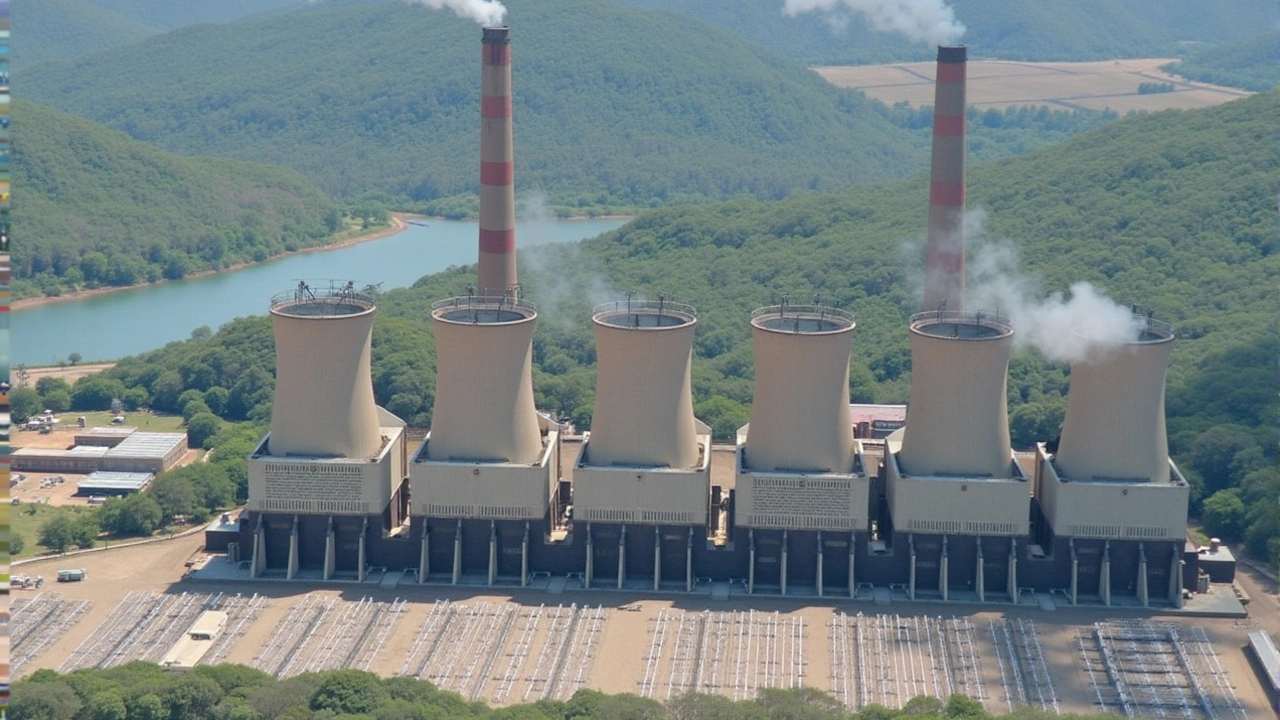Understanding the Context of Eskom's Decision
The South African power utility giant, Eskom, has unexpectedly announced the implementation of Stage 3 loadshedding, beginning at 17:00 on Friday, the 31st of January, 2025, and expected to continue until midnight on Sunday. This decision follows an impressive streak of over ten months without any such interruptions, attributed largely to the success of the Generation Recovery Plan. However, recent breakdowns requiring extended repair times have necessitated this temporary measure. The stopgap action aims to replenish the depleted emergency reserves that have played a critical role in maintaining the power supply so far. Eskom Group Chief Executive, Dan Marokane, characterized this development as a "temporary setback" and reassured that general loadshedding scenarios are mostly a thing of the past, citing the structural improvements in the generation fleet.
Structural Improvements and Challenges
Despite the current loadshedding, Eskom's overall trajectory continues to be positive. Dan Marokane emphasized the structural advancements made, aimed at significantly enhancing the reliability of power supply. The ongoing loadshedding period over the weekend has the specific purpose of allowing the utility to restore the Open-Cycle Gas Turbines and other reserves in preparation for the challenges of the coming week. A portion of Eskom’s strategy has been to anticipate potential issues, detailed in their Summer Outlook published in August of 2024. It is outlined that if unplanned outages reach 14,000MW, Stage 1 loadshedding might be necessary, and if they rise to 15,000MW, Stage 2 might be called upon. Currently, unplanned outages have risen to 13,313MW, but there’s an observed trend of decrease, reinforcing a sense of cautious optimism within the company.
Replenishment and Maintenance: A Strategic Approach
Dan Marokane highlighted the critical timeline that Eskom is working with. By the 3rd of February 2025, about 3,410MW is projected to return to service, an effort intending to alleviate the pressure off the strained power grid and progress towards more dependable power availability. The company's adherence to a detailed and strategic scheduled maintenance routine, at current totals of 6,177MW, coincides with their summer plan designed to boost reliability in the approaching winter of 2025 and beyond. This maintenance strategy is pivotal to ensuring that the lessons of past power shortages are turned into strategic foresight for the future.

Community Challenges: An Ongoing Battle
In addition to system-wide loadshedding challenges, Eskom faces serious local network issues like network overloading. These are predominantly due to illegal connections, vandalism, meter tampering, and theft of network equipment. Such illegal activities exacerbate the delicate balance between supply and demand that Eskom strives to manage. Eskom has urged the public to report any suspicious or illegal activities through the Eskom Crime Line or via specified WhatsApp channels, to assist in curbing these pressing issues and preserving the integrity of the power network.
Financial Strategy and Resource Management
Eskom's meticulous resource management efforts have yielded significant savings. Group Executive Bheki Nxumalo pointed out that structural enhancements and upliftments to the coal-fired generation fleet have been sustained, ensuring safety and efficiency gains. Significantly, the organization realized savings of R16.30 billion in diesel expenditure between April 1, 2024, and January 30, 2025. These funds are crucial to reinforcing Eskom’s financial position and promoting long-term sustainability in operational resources without compromising service quality.
Commitment to Ongoing Communication
Eskom reassures its stakeholders that communication regarding the status of power supply and loadshedding will remain frequent and transparent. The subsequent update is scheduled for Sunday, February 2, 2025. As the company targets a comprehensive turnaround strategy, it remains diligent in monitoring and optimizing the energy availability factor (EAF) which has shown an increase to 62.96% in the current financial year. This marks a noticeable improvement compared to 55.27% in the previous period, depicting an upward trend driven by strategic interventions and optimized operations.

Conclusion
The interrupted power supply and the adopted loadshedding stage serve as a stark reminder of the challenges that persist within the energy landscape. However, Eskom’s robust strategy to overcome these challenges speaks to a future of increased stability and reliability in electricity supply. With ongoing efforts in resource management, network stabilization, and strategic communications, the utility aims not merely to manage symptoms of issues but fundamentally addressing the underlying complexities that have historically affected South Africa’s power grid.

Kasey DellaPenna
February 1, 2025 AT 03:32Wow what a rollercoaster for Eskom this weekend it really shows how resilient the grid can be keep the faith we’ll get through this together
Gayleen Lowrie
February 8, 2025 AT 14:57It’s encouraging to see the utility taking proactive steps to boost reserves while keeping the community informed and involved.
Wesley Nakamatsu
February 16, 2025 AT 02:22One must commend Eskom’s strategic foresight; however, the recurrence of load‑shedding underscores systemic inefficiencies that demand rigorous reform.
Tyler Tucker
February 23, 2025 AT 13:47Seriously this is just drama on top of drama the utility keeps shocking us with surprise outages
julia mutambara
March 3, 2025 AT 01:12Friends, let’s take a moment to appreciate the silver lining of this temporary setback; while the lights flicker, we are reminded of the importance of community resilience, and it is precisely in these dark hours that our collective spirit shines brightest. The fact that Eskom can mobilize gas turbines so quickly demonstrates a level of operational agility that many praised as a hallmark of modern energy management. Moreover, the reported savings in diesel costs reflect a disciplined financial approach that should inspire confidence among stakeholders. It is also crucial to recognize that illegal connections and vandalism remain significant challenges, and addressing them will further stabilize the grid. By engaging citizens through the Crime Line and WhatsApp channels, the utility empowers us to become active participants in safeguarding our power supply. The upward trend in the Energy Availability Factor, moving from 55% to nearly 63%, signals tangible progress that should not be overlooked. While we may grumble about the inconvenience, the strategic maintenance schedule aligns with long‑term reliability goals, especially as we head into the colder months. In addition, the renewed focus on renewable integration promises a cleaner energy future for South Africa. Let’s stay optimistic, support each other through the brief outages, and celebrate each incremental win on the road to a more stable grid.
Daniel Craine
March 10, 2025 AT 12:37Honestly, this whole situation reeks of mismanagement!!! Eskom is supposed to be the backbone of the nation, yet we keep seeing slap‑dash decisions; the fact that they need Stage 3 loadshedding after months of supposedly flawless operation is a clear indicator of deeper operational flaws-time to overhaul their maintenance protocols, now!!!
Kristen VanPamel
March 18, 2025 AT 00:02The philosophical underpinning of power distribution is simple: supply must meet demand, yet the societal structures that allow theft and vandalism distort this equilibrium.
Giacinta Pace
March 25, 2025 AT 11:27It’s good to see the utility trying to fix the problem, let’s all do our part and report any shady activity.
darryl archer
April 1, 2025 AT 22:52Whilst the report appears comprehensive, one cannot ignore the persisting infrastructural deficits that continue to undermine systemic efficacy.
Dina DiCicco
April 9, 2025 AT 10:17We need to push for faster fixes 🚀💡
Nelleke Elston
April 16, 2025 AT 21:42All this “optimism” feels forced; the real issue is that we keep getting the same old excuses.
pragya bharti
April 24, 2025 AT 09:07One could argue that every setback is merely a catalyst for deeper introspection into our energy policies.
Soundarya Kumar
May 1, 2025 AT 20:32These outages are a minor inconvenience.
Rohit Bafna
May 9, 2025 AT 07:57From a systems‑engineering standpoint, the current load‑shedding protocol exhibits suboptimal resiliency metrics, necessitating an accelerated integration of smart‑grid technologies and predictive analytics.
Minal Chavan
May 16, 2025 AT 19:22We appreciate the measured communication from Eskom and remain hopeful for sustained improvements.
vikas duhun
May 24, 2025 AT 06:47Honestly this drama feels endless, but let’s hope the next update shows real progress, otherwise we’ll all be shouting into the void.
Liz Lessner
May 31, 2025 AT 18:12Stay safe and keep the community spirit alive, even when the lights go out.